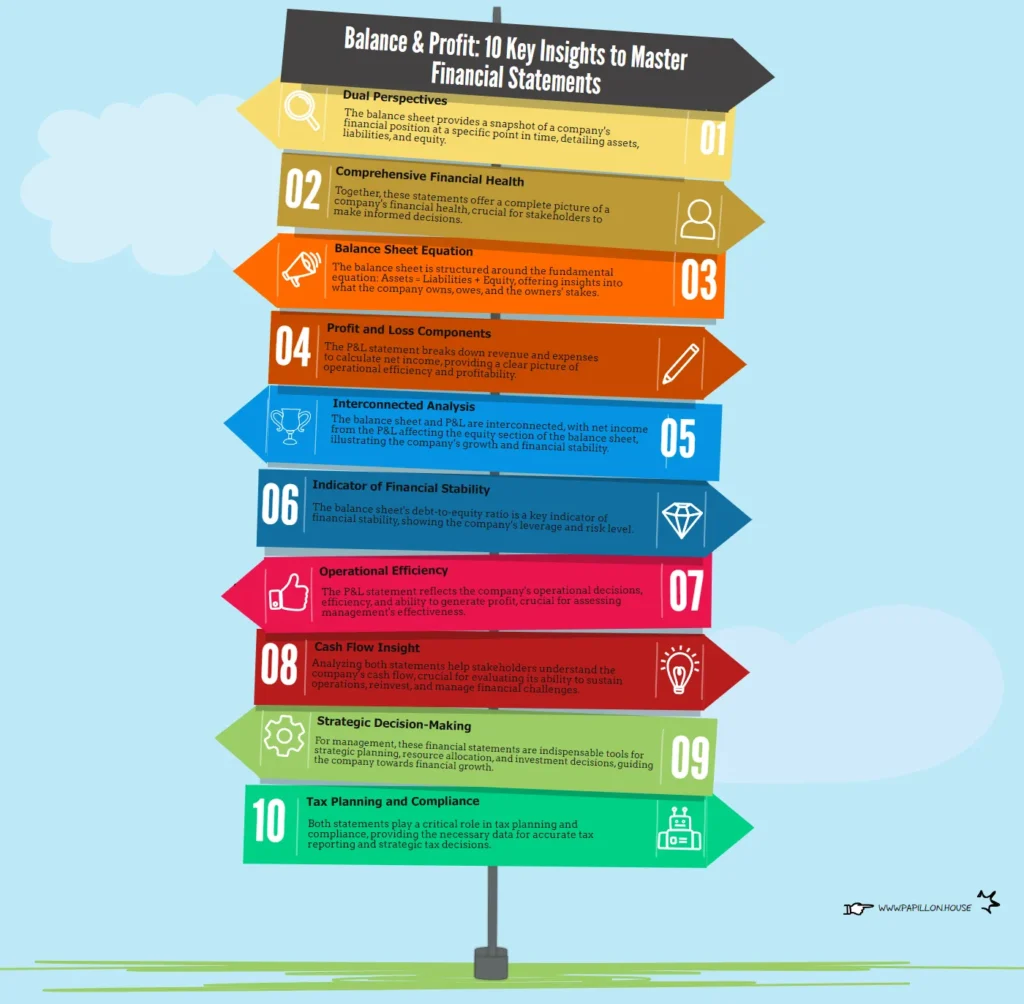
Balance Sheet Vs Profit and Loss: Unveiling Financial Narratives Through Comparative Analysis


In the financial narrative of any business, two statements reign supreme: the balance sheet and the profit and loss statement (P&L). Like the two sides of a coin, each tells a distinct but interrelated story about a company’s financial health. The balance sheet presents a snapshot of a company’s assets, liabilities, and equity at a specific point in time, revealing what the business owns and owes. In contrast, the profit and loss statement unfolds the performance story over a period, chronicling revenues, costs, and expenses to illuminate profitability.
Interpreting these financial statements can be akin to reading a map and a diary simultaneously. The balance sheet serves as a map, guiding stakeholders to assess the terrain of a company’s financial position. It offers solid ground for investors and shareholders to ascertain actual value and potential for future investment. Meanwhile, the P&L statement reads as a diary, providing a historical account of operational efficiency and reflecting decisions made by management. Together, they enable a comprehensive understanding of business sustainability and potential for growth, giving life to numbers that would otherwise seem static.
Key Takeaways
- The balance sheet and profit and loss statement are fundamental tools for assessing a company’s financial health.
- These statements offer both a point-in-time and a dynamic view of a company’s financial state, which is crucial for stakeholders.
- Combined analysis leads to informed investment decisions and sound financial planning for businesses.
Understanding the Fundamentals
In the realm of financial reporting, two documents stand as pillars revealing a company’s economic health: the balance sheet and the profit and loss statement. Each illuminates distinct but interconnected aspects of a business’s financial status.
The Essence of Financial Statements
Financial statements are vital tools for investors, stakeholders, and management to gauge a company’s fiscal strength and operational efficiency. The balance sheet provides a snapshot of what the company owns and owes at a given point in time, while the profit and loss statement shows how well the company generates revenue over a period.
Components of a Balance Sheet
A balance sheet is structured around the fundamental equation: Assets = Liabilities + Equity.
- Assets: These are resources the company owns, which are expected to yield future benefits. Assets are often divided into current assets, like cash and inventories, and long-term assets, like property and equipment.
- Liabilities: These are obligations the company must fulfill in the future, such as loans, accounts payable, and other debts.
- Equity: This represents the owners’ claim on the business after liabilities are paid off and encompasses retained earnings and shareholders’ equity.
| Assets | Liabilities | Equity |
| Cash and Cash Equivalents | Accounts Payable | Retained Earnings |
| Inventory | Debt | Shareholders’ Equity |
| Property, Plant, & Equipment | Other Liabilities | – |
Components of a Profit and Loss Statement
The profit and loss statement (P&L), or the income statement, tracks revenue and expenses to calculate profit or loss over a specific period.
- Revenue: The total income generated from sales of goods or services before any costs are deducted.
- Expenses: The costs incurred in the process of generating revenue, including cost of goods sold (COGS) and operating expenses.
- Net Income: The remainder when expenses are subtracted from revenue, which can be either a profit or loss.
The balance sheet and the profit and loss statement together provide a comprehensive overview of a company’s financial well-being. Assets and liabilities depicted in the balance sheet are directly influenced by the results of the P&L statement, where net income eventually contributes to the equity on the balance sheet.
Analyzing Financial Health
Financial statements serve as a compass guiding stakeholders through the economic landscape of a company. The health of a business is not visible to the naked eye, but it’s readable through the numbers and narratives crafted within its financial records.
Evaluating Company Performance
To holistically assess a company’s performance, one must consider both the balance sheet and the profit and loss (P&L) statement.
A balance sheet is a financial statement that gives a snapshot of a company’s financial condition at a specific moment. It details the company’s assets, liabilities, and shareholders’ equity, providing insight into what the company owns and owes, as well as the amount invested by the shareholders. In contrast, the P&L statement records revenues and expenses over a period, offering insight into operational efficiency and the ability to generate profit. They use financial ratios derived from these statements for a clear view of performance.
Indicators of Profitability
A company’s profitability is often judged by its net profit, the definitive bottom line on the P&L statement. However, profitability does not equate to financial health without context. The balance sheet plays a crucial role, highlighting the company’s debt levels relative to its equity, a key indicator of financial stability. Operations that manage to expand while maintaining a solid balance between incoming cash and liabilities are typically seen as profitable and robust.
Understanding Cash Flow
Examining the cash flow statement is crucial in evaluating financial health. This statement resolves the mystery of whether operations are truly generating the cash necessary to support ongoing and future business endeavors. When a company’s liquid assets grow, leading to positive cash flow, it signifies its capacity to cover debts, reinvest, manage expenses, and prepare for potential financial hurdles. In contrast, a pattern of negative cash flow could be a warning sign, indicating potential issues with the company’s long-term financial stability and health.
Practical Application for Stakeholders
The precise analysis of the Balance Sheet and Profit and Loss Statement is paramount for stakeholders to make informed decisions regarding resources, investments, and taxes. These financial statements are indispensable tools for stakeholders ranging from management and shareholders to lenders and tax authorities.
Investor Insights
Investors closely scrutinize a company’s Balance Sheet and Profit and Loss Statement to assess financial health and future potential. The Balance Sheet provides a snapshot of a company’s financial standing, including shareholders’ equity, indicating the net worth after subtracting liabilities from assets.
In contrast, the Profit and Loss Statement, also known as the Income Statement, offers a dynamic view of the company’s operations over a period of time, showcasing revenue streams and expenditures. Earnings and expenses detailed in this statement answer crucial questions about the company’s profitability, which translates into potential dividend yield for shareholders.
Management Decisions
Management relies on both statements to steer the company in the right direction financially. The Income Statement reflects the outcome of management’s operational decisions, revealing patterns in income and expenses that dictate where to cut costs or invest more. This statement is a litmus test for the strategies adopted by the management and their effectiveness over time.
The Balance Sheet complements this view by highlighting the current state of the company’s resources. Management can devise strategic plans for finance allocation and investment opportunities by examining assets, liabilities, and shareholders’ equity. The interplay between the two statements permits management to assess liquidity and leverage, crucial factors in making informed business decisions.
Tax Planning and Compliance
Both the Balance Sheet and the Profit and Loss Statement are integral to tax planning and compliance. The IRS requires accurate and detailed financial records to determine the correct amount of taxes owed. Lenders and investors often consider these documents when deciding whether to provide financing or invest in a business.
The Balance Sheet shows the company’s financial position at year-end and includes important tax-related information such as depreciation on assets and reserves. On the other hand, the Profit and Loss Statement details the taxable income, inclusive of revenue and deductibles such as operating expenses and cost of goods sold. Together, these statements provide a foundation for tax preparations, ensuring businesses meet regulatory requirements and maximize tax efficiency.

Deep Dive into Balance Sheet Analysis
A balance sheet serves as a snapshot of a company’s financial standing, capturing the essence of asset management, liability oversight, and equity evaluation. This detailed analysis keys into the optimization, control, and assessment necessary for a firm’s financial health.
Asset Management and Optimization
Effective asset management leverages both current assets—like cash and inventory—and fixed assets, such as property and equipment. Intangible assets, including patents and trademarks, combined with long-term investments, reflect the company’s future earning potential. The aim is to optimize the asset mix for liquidity and return on investment, ensuring assets are not just owned, but also efficiently utilized.
Liability Control and Structure
A thorough inspection of the company’s current liabilities reveals its short-term financial obligations, while examining long-term liabilities discloses debts payable over a longer period. Minimizing the cost of liabilities, such as interest expenses, and maintaining a robust structure equips a company with the durability to withstand fiscal pressures.
Equity Assessment for Growth
The equity section of the balance sheet, reflecting factors such as retained earnings and additional paid-in capital, narrates the story of a company’s growth and how it is financed. Retained earnings highlight profits that are reinvested into the company, an indicator of a company’s long-term commitment to growth.
- Retained Earnings: Profits that have been plowed back into the company over time.
- Equity: A testament to the company’s value, as perceived by shareholders and invested capital.
Through a balance sheet, stakeholders can examine the stability and potential of a company in handling its total assets, gauging how effectively it’s gearing up for future challenges and opportunities.
Deep Dive into Profit and Loss Analysis
The Profit and Loss (P&L) statement is a financial narrative, capturing the performance of a business over a set period. It tells the story of financial successes and challenges through its examination of revenues, expenses, and net income.
Revenue Recognition and Growth
Revenue, often referred to as the top line, embodies the initial chapter of the P&L statement’s tale. It provides insight into the effectiveness of a company’s sales and marketing efforts. A company recognizes total revenue when it successfully sells goods or services, which is reflected on the P&L statement. Growth in this area is a positive indicator of market demand and the company’s ability to attract and retain customers.
Expense Management and Efficiency
The following chapter details costs and expenses, integral to the plot of financial storytelling. They document the money a company spends to generate revenue. Clever expense management can reflect a company’s commitment to efficiency. Operating income, a subtext of the P&L story, emerges after subtracting expenses from gross profit, revealing the cost control’s effectiveness.
Net Income and Bottom Line Focus
In the narrative arc of the P&L statement, net income anchors the conclusion, often termed the bottom line. This figure crystallizes from the climax of total revenue confronted by the aggregate costs and expenses. A focus on the bottom line is paramount as it demonstrates the company’s ultimate profitability and its ability to generate profits, narrating the company’s final financial standing for the period.
Integrating Balance Sheet with P&L
When dissecting the financial health and performance of a business, the integration of the Balance Sheet and the Profit and Loss (P&L) Statement is crucial. Together, these statements offer a comprehensive view of the company’s operations, financial position, and its ability to generate cash from operating, investing, and financing activities.
How do the Statements Complement Each Other?
The Balance Sheet and P&L Statement serve distinct but interrelated purposes. The Balance Sheet provides a snapshot of the company’s financial position at a specific point in time, detailing assets, liabilities, and shareholders’ equity. In contrast, the P&L Statement shows the company’s financial performance over a period, summarizing revenues, expenses, and net income. To illustrate, when a company makes a sale, it’s recognized as revenue on the P&L, but the cash received from the sale increases the cash account on the Balance Sheet.
Impact of Balance Sheet on Profit and Loss
The Balance Sheet can significantly influence the P&L through its reflection of the company’s financing and investing activities. For instance, acquiring assets usually impacts cash flow, while the method of financing those assets—whether through equity or debt—will affect the company’s expenses due to interest payments.
Impact of Profit and Loss on Balance Sheet
Conversely, the P&L can affect the Balance Sheet; it’s not a one-way street. Profits enhance shareholders’ equity while losses can deplete it. Moreover, operational cash flow, driven by net income from the P&L, may be reinvested back into the company, potentially showing under ‘Investing’ activities, or used to pay down debt, listed under ‘Financing’ activities on the Balance Sheet.
Advanced Topics in Financial Analysis
In the realm of financial analysis, two vital practices stand at the forefront: dissecting financial ratios and honing the precision of forecasting and projections. Both subsections delve into a company’s financial performance and position, enhancing our understanding of its liquidity and predicting future financial health.
Leveraging Financial Ratios
Financial ratios are instrumental tools that analysts use to assess a company’s financial health. Ratios like the current and quick ratios directly engage with a company’s liquidity—its ability to meet short-term obligations. Profitability ratios such as the gross margin ratio and return on assets (ROA) illuminate aspects of financial performance, revealing efficiency in utilizing resources. When analysts look at leverage ratios like the debt-to-equity ratio, they are evaluating a company’s financial position, especially its capital structure and risk level.
Liquidity Ratios:
- Current Ratio: Current Assets / Current Liabilities
- Quick Ratio: (Current Assets – Inventory) / Current Liabilities
Profitability Ratios:
- Gross Margin Ratio: (Revenue – Cost of Goods Sold) / Revenue
- Return on Assets: Net Income / Total Assets
Forecasting and Projections
Forecasting and projecting financial outcomes necessitate both art and science, drawing on past and current financial statements to envision future performance. Analysts employ methods like trend analysis, regression models, and scenario planning. While projections are typically built on the profit and loss statement, factoring in revenue and expense trends, the balance sheet’s data feeds into forecasting the entity’s financial health, closely examining assets, liabilities, and equity to predict future liquidity levels and capital needs.
Forecasting Methods:
- Trend Analysis: Extending historical financial trends into the future.
- Regression Models: Using statistical methods to predict future performance.
These advanced analytical techniques empower stakeholders to make informed, strategic decisions, ensuring a company’s stability and growth over time.
Expertise in Numbers, Peace of Mind in Business – Discover Financial Precision with Papillon House
In today’s fast-paced business world, the margin for error in financial management is razor-thin. Papillon House stands as your bulwark against these uncertainties. With over a decade of experience in diverse financial niches, we bring unparalleled precision to your bookkeeping and financial strategies.
Whether it’s navigating complex tax planning, ensuring payroll accuracy, or delivering comprehensive financial reports, our expertise is your peace of mind.
Don’t let financial complexities be the weak link in your business chain. Choose Papillon House for financial accuracy that powers your business forward. Visit Papillon House now – where your financial integrity is our priority

Frequently Asked Questions
How do the balance sheet and profit and loss statement complement each other in financial reporting?
The balance sheet provides a snapshot of a company’s assets, liabilities, and equity at a specific point in time. In contrast, the profit and loss statement records revenues, expenses, and profits over a period, demonstrating the company’s operational performance. Together, they offer a complete picture of financial health: one reflecting the current state, the other tracking the operational flow.
In what ways can a balance sheet reveal a company’s financial health not shown on a profit and loss statement?
A balance sheet shows a company’s solvency and liquidity by detailing its assets and liabilities. This reveals the capacity to settle short-term debts with its current assets and manage long-term obligations. By assessing the equity section, one can discern how much capital has been invested by the owners and the retained earnings, aspects not directly visible on a profit and loss statement.
Which elements are unique to the balance sheet format that aren’t found in a profit and loss account?
The balance sheet includes assets such as cash, inventory, and property, as well as liabilities like loans and creditor obligations. Equity, representing the residual interest in the assets after deducting liabilities, is also exclusive to the balance sheet. In contrast, the profit and loss account, more formally known as the income statement, focuses solely on income and expenses.
Can you explain the method of showing net profit within the balance sheet and its impact on a company’s equity?
Net profit from the profit and loss statement is added to retained earnings within the equity section of the balance sheet. This increment reflects the portion of profit that is reinvested in the company rather than distributed as dividends. Consequently, the increased equity indicates greater internal funding and can signal growing financial strength.
What are the main differences between an income statement and a profit and loss statement, and why is each critical for business analysis?
The income statement and the profit and loss statement are terms often used interchangeably to describe the same financial report, which outlines revenues, costs, and expenses to depict the company’s profitability. This statement is critical for business analysis as it highlights the ability to generate profit by comparing income against expenses.
What are the best practices for analyzing financial statements to understand a company’s performance comprehensively?
Best practices for financial statement analysis include performing horizontal and vertical analysis, ratio analysis such as liquidity ratios, profitability ratios, and debt ratios, and understanding the cash flow statement to see the actual liquidity position. Analyzing these statements in tandem rather than in isolation leads to a more holistic view of a company’s performance.
About Morgan

Morgan is the Director at Papillon House Bookkeeping, a Tampa, Florida-based firm that specializes in bookkeeping services for law offices, architects, and the construction industry. With over three years of experience in her current role, she aids her clients in meticulously organizing their financials. Morgan's dedication and expertise extend beyond the realm of accounting, allowing her to provide comprehensive financial management solutions. She also engages with her audience through live discussions on the Papillon House Bookkeeping Facebook group page.




